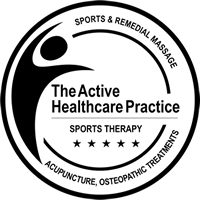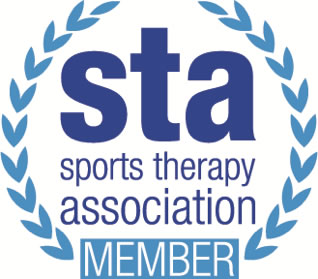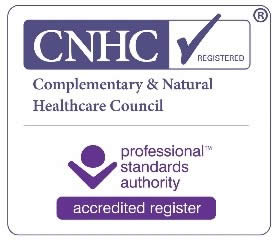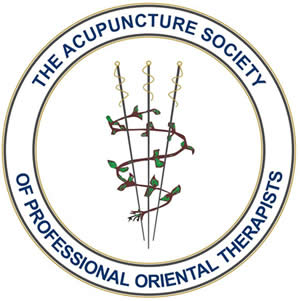Welcome to The Active Healthcare Practice
5 Star Sports & Clinical Therapy services for every body, sporting and non-sporting alike.
You don’t have to be an athlete to benefit from treatments at The Active Healthcare Practice, we treat elite and amateur athletes, as well as non-sports people to help with improving your quality and quantity of movement.
We have a range of treatments to help with pain, mobility and flexibility and offer treatments for acute injuries and chronic problems.

About Active HCP
The Active Healthcare Practice was established in 2016 with the vision of being able to provide a multidisciplinary approach to treating pain, injury and optimising function for musculoskeletal problems, all under one roof.
We are proud members of the Sports Therapy Association, Sports Massage Association and are registered with the Complimentary and Natural Healthcare Council.
Our clinic in Poole, Dorset, offers a comfortable, relaxed setting whilst maintaining the strictest hygiene measures.
Available Treatments
Sports massage
Sports Therapy & Injury rehabilitation
Kinesio taping
Medical Acupuncture
Osteopathic Manipulation
Clinical Yoga & PNF Stretching
Online consultations & classes

Sports Massage
Originally developed for athletes to prevent and relieve injuries, but it’s also great for non-athletes, working particularly well to improve muscle flexibility and reduce pain.

Sports Therapy & Injury rehabilitation
We have a range of treatments to help with recent, as well as old injuries to help you back to optimum health as quickly as possible.

Kinesio taping
Widely used by elite athletes, Kinesio Taping has established a worldwide reputation as the most trusted name in therapeutic taping.

Medical Acupuncture
The use of Medical Acupuncture on painful myofascial trigger points can be a very effective treatment.

Osteopathic Manipulation
Osteopathic techniques help to improve quality and quantity of movement. Sometimes these techniques are known as joint alignment or adjustment, ‘cracking’ or ‘clicking’.

Clinical Yoga & PNF Stretching
Improve balance, strength and flexibility by learning how to progress in yoga in a way that minimises the risk of injury. Safe, controlled movement to help improve your overall fitness.
About Me
Julia founded the Active Healthcare Practice in 2016 after initially training as a Sports Massage Therapist. She had sustained a back injury in 2014 and found that whilst a range of therapies helped get her back on her feet again, she was unable to find one practitioner who could provide a broad range of therapies alsongside rehabilitation and hence the Active Healthcare Practice was established to fill that gap.
She is proud to have had the opportunity to train with world renowned tutors in a multitude of disciplines including Sports Massage, Exercise Prescription, Osteopathic Treatments, Medical Acupuncture, Nutrition, and Clinical Yoga.
She holds a level 4 ITEC diploma in Sports Massage therapy, with additional training in lymphatic massage and post operative care; alongside a Level 4 Personal Training and Exercise Referral specialist qualification.
She holds the renowned OMT Diploma in Osteopathic Articulation and is a certified OMT Osteopathic Advanced Spinal and Peripheral Manipulation and OMT Medical Acupuncture practitioner.
Adding to her qualifications Julia is an FHT accredited Clinical Yoga Instructor and holds certifications in Nutrition, Advanced Kinesio Taping and is a Leader in Running Fitness with England Athletics.
What Is Sport Therapy and Who is it For?
Whenever you are considering visiting a Sports Therapist it’s very likely you’re going to have lots of questions. To help you decide if this is right for you we’ve created a list of some of the most common questions and concerns people have.
Should I see a Sports Therapist or a Physiotherapist.
Both professions are trained and insured to treat musculoskeletal disorders but there are some differences in their training and approach. Both treat pain and injury through hands-on treatment methods (manual therapy), rehabilitation and patient education.
Whilst it really depends on the individual therapist’s education, experience and interests, broadly speaking;
Physiotherapists have a broader knowledge base and medical background, which allows them to treat illnesses, diseases, neurological and respiratory issues. This makes them ideal for treating a wide range of patients, including complex patients with multiple conditions. Physiotherapy usually attempts to rehabilitate patients to allow them to feel comfortable and cope in their day-to-day life.
Physiotherapy is a protected title and is regulated by the Health and Care Professions Council.To be able to use the title Physiotherapist or Physical Therapist, practitioners must have graduated from an approved University degree course.
Sports therapists are experts in musculoskeletal disorders and generally have more exposure to sporting environments making them ideal for preventing and treating sports injuries through specific strengthening programmes.
Sports therapy generally focuses on returning or maintaining the patient or client to an optimum physical level for whatever sporting activity, or other physical activity they would like to carry out.
BUT it really depends on the therapist. Lots of Physiotherapists have experience in sport and lots of Sports therapists work with people who are not active. To get the most from your therapist, you should choose your practitioner based on their individual experience and expertise.
At the moment, Sports Therapist is not a protected title and is currently not mandatorily regulated, so in theory, anyone with a basic sports massage qualification and some exercise knowledge could call themselves a Sports Therapist. However, most reputable Sports Therapists choose to be voluntarily regulated, having met strict National Occupational Standards and are members of professional bodies, who check Member’s qualifications and require members to regularly update skills and knowledge.
What is Manual Therapy?
Manual therapy is the term we use to describe hands on treatment modalities. These might include
- Massage
- Join and tissue mobilisations, articulations, manipulations
- Acupuncture
- Taping
- Cupping
Does sports massage hurt?
Sports Massage is a deep massage, which should be firm but not really painful. If you’re gritting your teeth or left covered in bruises, your therapist is doing it wrong. Lots of people wrongly believe that it needs to hurt to be effective. Sometimes certain areas may be particularly sensitive and uncomfortable in the short term, but your therapist should always work within your pain threshold and a sports massage should be a positive experience.
My friend has his muscle knots ‘stripped’ by his sports massage therapist. Do you do that?
Good grief, no. That’s ‘bro science’. Tell your friend to get a new therapist, or at the very least, ask the therapist to explain what they’re doing and why. Sometimes we use tools which look like we are scraping the muscles, but in the right hands, it’s actually quite comfortable. An experienced therapist who has undergone advanced training will love passing on knowledge to clients so that you can understand your body better. If it’s all smoke and mirrors and Bro Science, run.
I heard about a guy at the gym who treats a famous cyclist. He must be amazing, right?
He may very well be amazing, yes. The famous cyclist must certainly think he’s great!
But if you haven’t got a bike and you’ve got neck pain from your desk job, the guy at the gym might not be the right therapist for you. Ask questions. Good therapists love questions!
Will it cure my back pain?
Maybe, it’s rare, but it has happened! Realistically, on it’s own, treatment probably won’t cure your back pain. During treatment we aim to create a ‘window of opportunity’ where we improve quality and quantity of movement and reduce pain, so that you can start moving better. That’s the key to curing your back pain, movement. Alongside hands on treatment, I’ll give you a plan which will involve movement exercises for you to do at home
It’s highly likely that you’ll feel a lot better after your treatment, and you might feel that you don’t need to do the exercises that I give you. If you want to cure that back pain for good, you probably need to do the exercises.
How many sessions will I need?
That depends on the problem. Sometimes one treatment is enough to get you moving enough for you to manage your treatment at home on your own. If a condition isn’t improving after 3 treatments, sometimes I will refer you to your GP or a Specialist for further investigation. Some clients come for regular maintenance treatments.
Can you crack my neck and back?
Yes, I can, after thorough screening, assessment and if it’s appropriate.
My Chiropractor cracks my back but the pain comes back after a while. Will your treatment work better?
The manipulation techniques that I use are the same that the Chiropractor or Osteopath uses. Manipulation causes temporary changes which can relieve pain and increase range of movement. I use a variety of soft tissue techniques alongside manipulation, so the overall treatment may be slightly different, but the honest answer is that I don’t know. It depends what you’re doing at home. Treatment is only 20% of the whole picture. You need to make changes too.
Do you do acupuncture to help with things like the menopause, weight loss or giving up smoking?
No. That’s TCM acupuncture (Traditional Chinese Medicine). You can find a registered TCM Acupuncturist here
How often should I have treatment?
I may recommend a course of treatment for an injury (usually up to 3, a week or two apart) For maintenance treatments, That’s up to you. I would recommend leaving a week between treatments. Some people come weekly, fortnightly or monthly for maintenance treatments to help their muscles stay supple and because they enjoy treatment.
I don’t do any sport, how can a sports massage help?
Absolutely. Sports massage is great for any body. It helps keep muscles supple (healthy, supple muscles tend to be less painful and allow for better movement).
Will Sports Massage improve my performance or prevent me from getting injured?
The very latest research says that Sports Massage alone does not improve performance, but can help the body to recover more quickly. You shouldn’t have a sports massage immediately before an event, as it can actually decrease performance. For pre-event massage, we use a special method to warm the muscles up and prime them for activity, but it’s not the same technique that you would generally have during a treatment.
Sports Massage can improve flexibility and can prevent injury, but it’s important to have a well rounded strength and mobility program in your training schedule to prevent injury. A sports therapist can help you with this.
I had an injury 20 years ago, you can’t do much about that, right?
I can help with chronic (long term) problems as well as acute injuries. It may take a little longer, but it won’t take 20 years to make you feel better!
Do you do Myofascial Release?
Yes, i use it within a range of treatments. I don’t generally use it as a stand alone treatment as I use a blend of methods best suited to what’s going on with your body.
I don’t want to do the exercises you give me. Is that ok?
Yes, that’s absolutely fine if you really don’t want to do your exercises, if coming to see me once a week or once a fortnight to keep you pain free and mobile suits you better. As long as you understand that if you don’t do the rehab, your pain relief is only going to be temporary. The changes we make in clinic won’t last if you don’t put in the homework.
Are you qualified and insured?
Absolutely. I’m fully qualified in a variety of disciplines including Sports Massage, Physical Activity (PT) Medical Acupuncture, Osteopathic Manipulation and Clinical Yoga. I continually update skills with regular professional development courses. I’m insured with BGi, one of the leading Manual Therapy Insurers. I’m also voluntarily regulated by the widely recognised Complimentary & Natural Healthcare Council and am a member of the Sports Therapy Association, Sports Massage Association and the British Acupuncture Society.
I’m paying for a 1 hour session, does that mean 1 hour on the couch being treated hands on?
No, you’re paying for an hour’s consultation with treatment and it includes time to get dressed and prescribing exercise. Sometimes on a first treatment, the consultation part can take 20-30 minutes. Usually on subsequent treatment, an hour’s session will involve approx 50 mins hands on treatment time.
How long do I need?
Broadly speaking, upper body massage treatments such as back neck and shoulders require 45 minutes and lower body massage treatments require 60 minutes. Sports Massage has a powerful effect on your body’s central nervous system and I would strongly advise to split upper and lower body treatments over two sessions.
Sports Therapy Sessions focus on specific areas of injury or dysfunction and may include acupuncture, cupping and mobilisation. These can be booked for 30 minutes or 45 minutes.
Can I workout after my treatment
I would advise you to rest after your treatment. Treatment has a strong effect on the body and sometimes you can experience a range of temporary side effects including tiredness and a temporary increase in symptoms. After your treatment, you’ll be given an aftercare sheet to help you benefit the most from your treatment.
You can return to your normal routine after 24 hours
Do do you do home visits
No, sorry. Treatment is only available at the clinic in Creekmoor, Poole, Dorset.
Will I have to take my clothes off?
Yes, I need access to your skin! In your first appointment, I also need to be able to see how your body moves. Don’t worry, I’ll do my best to keep you at ease. You’ll keep underwear on and you’ll be covered with towels during treatment.
Do you treat children
From the age of 14, yes, but anyone under the age of 18 needs to be chaperoned by an adult and have written parental consent.




